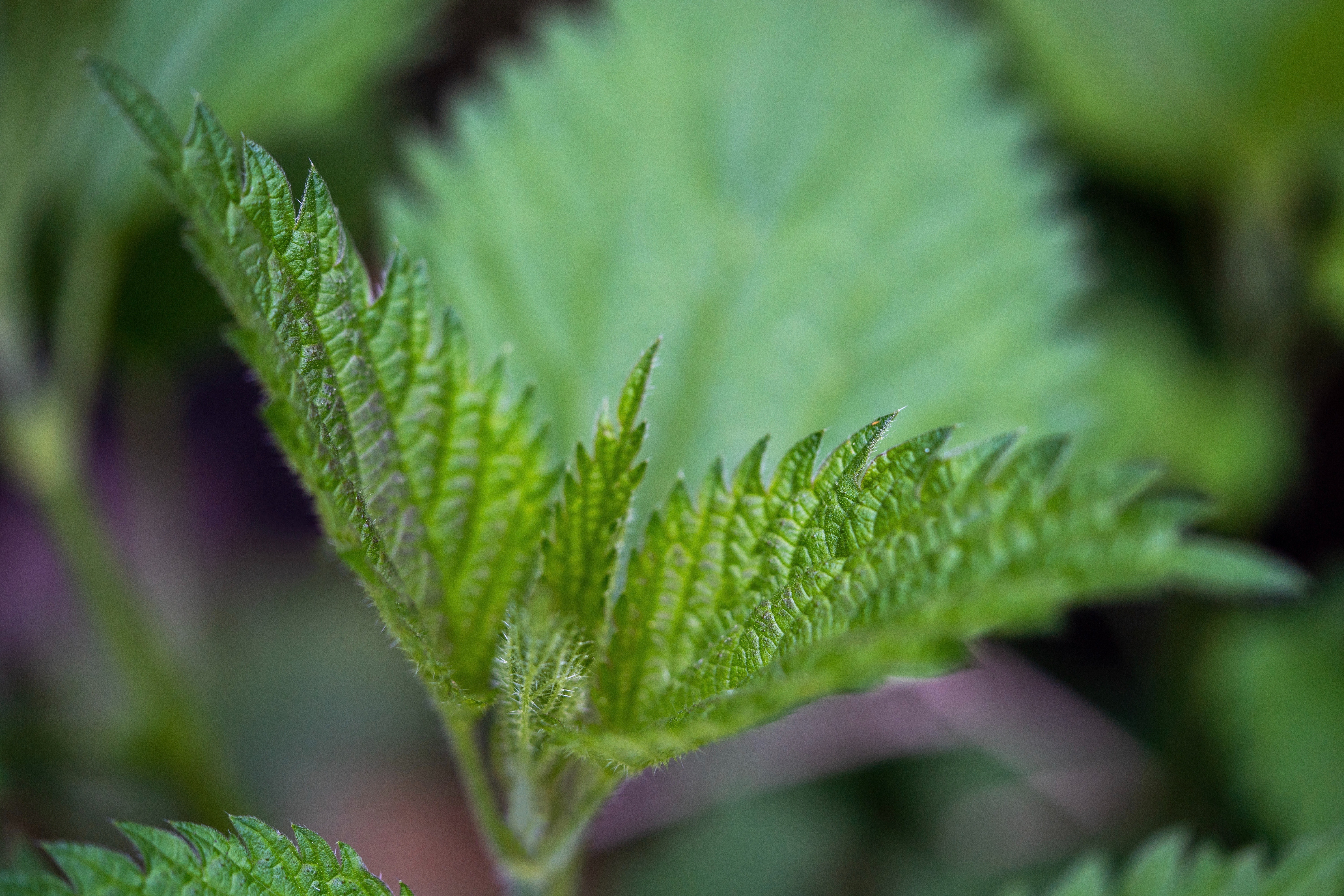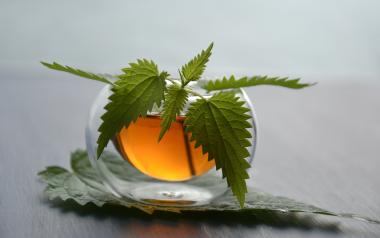Watching out for stinging nettle (Urtica dioica) when doing a happy spring dance barefoot may be wise, but make sure not to avoid this potent plant altogether, which is exactly what you need to freshen up your spring beauty regimen!
Stinging nettle is one of the very first plants to emerge in spring throughout many North American regions and is the bane of many flower bed gardeners. The traditional use of this seemingly exasperating plant has all but been forgotten. Around the world where stinging nettle grows, it has historically been harvested for a spring tonic to nourish and detox, reduce whole body inflammation, and to balance hormones and strengthen cellular tissue. What does reducing inflammation and supporting tissue cells have to do with your overall visage? I’m going to tell you!
Inside-Out Support for Glowing Skin
Stinging nettle is a plant capable of offering support from your bones to your dewy glow. Bodily systems have a direct impact on the aesthetic quality of the skin, including the musculoskeletal systems, circulatory and immune systems, along with the gastrointestinal, genitourinary, and endocrine organs. Good digestive function and bone health are important for the body’s proper assimilation of nutrients. When these systems are impacted negatively, cell repair and the elimination of defective cells is more difficult, leading to greater incidence of disease and external “red flags” such as acne, fine lines, rashes, pigmentation spots, and loss of elasticity. The bodily systems work together to keep proper functioning of the human body, and when working well, they add to the natural clarity and luminance of skin.
Nourishing nutrients
Stinging nettle has been called a “multivitamin herb” as it contains iron, selenium, magnesium, phosphorus, sodium, zinc, calcium, manganese, carotene, boron, iodine, chromium, copper, sulfur, vitamin A, B, C, and K, potassium, fatty acids, and protein. It is also high in antioxidants, as the dry leaves contain 4.8 mg of chlorophyll per gram (this can vary depending on whether your plant was grown in the sun or the shade). It is known that most of these nutrients are imperative for healthy looking skin, and some studies conclude that consuming or applying chlorophyll topically provides skin with anti-inflammatory and antimicrobial properties, helps to treat acne, minimizes the appearance of pores, and improves the signs of aging.
The bone health connection
Studies also show that there is a connection between the deterioration and dryness of skin and osteoarthritis, rheumatoid arthritis, and other bone pathologies. This makes sense when considering that connective tissue like bone is responsible for the fortitude of our bones, hair, nails, and skin. Connective tissue also has a role in the storage, absorption, and disposal of waste from the body. It transports vitamins, nutrients, and oxygen while also protecting us from harmful contaminants and providing immune support.
The quality of the skin, both in appearance and strength, is directly impacted by the vitality of the connective tissue, as it’s responsible for structural support, including: tendons, ligaments, bone and cartilage, thermal insulation (or fat), and blood production for bone marrow and lymphatic tissue. As a connective tissue, bone is composed of a solid extracellular matrix and cells, including osteoblasts, osteocytes, and osteoclasts. These are the three cell types involved in the development, growth, and remodelling of bones. Osteoblasts are bone-forming cells, osteocytes are mature bone cells, and osteoclasts break down and reabsorb bone.
In one Swiss study, male mice were administered stinging nettle during a maxillary expansion procedure—researchers found new bone formation and the number of osteoblasts, osteoclasts, and capillaries highest in the group of mice receiving doses of stinging nettle (Celal et. Al, 2016). In supporting the health of bones by consuming stinging nettle, we may also reduce symptoms of poor skin health.
Anti-inflammatory power
Stinging nettle is also a powerful anti-inflammatory, as it can impact the musculoskeletal system and subsequently, our skin too. A healthy maintenance of muscle mass is important for youthful-appearing skin. In our youth, the fat pads under the skin sit snugly together; but as skin ages, it begins to sag, and those pads become thinner and not as tightly fit together. Muscle is what gives skin fullness in this life stage. Aging has adverse effects on skeletal muscles, with the progressive deterioration of cellular tissue tightly related to inflammation.
In a study involving rheumatoid arthritis, an autoimmune disease characterized by chronic inflammation, hyperproliferation of the synovial lining, and cartilage destruction, stinging nettle was found to potentially regulate inflammatory mediators (Riehemann et. al, 1999). In reducing the overall inflammation in the body, many of the outer symptoms of internal inflammation, such as acne, redness, and dull and loose skin, are alleviated as well.
How to Add Stinging Nettle to Your Life
Now that we know stinging nettle should no longer be thrown aside but coveted, how do we go about getting into our daily regimen?

Harvest stinging nettle
The optimal time to pick stinging nettle is just before blossoms develop in spring and early summer. Stinging nettle is a cold season perennial plant, meaning it is early to pop up in the spring. It grows rapidly and will reach its typical 3–5-foot height quite quickly. Here where I live in Manitoba, ideal picking time is mid-May to June. The leaves will be at their best – bright green, tender, and there’s few insects. Once nettle has gone to seed, the leaves will become tough, a little bitter, and develop gritty particles that may irritate the urinary tract of some people. It is best not to harvest stinging nettle once the seeds form.
Wearing a sturdy pair of gloves, cut about 2–3 inches above ground level, just above where there are two leaves branching off. Cutting here encourages new growth; by mid-summer, you should be able to harvest these again. Store your cuttings in a paper bag or basket.
Note: Plastic bags do not breathe and may cause condensation, which will cause mold to grow if you don’t empty the bag right away.
Make a tea infusion
One of the easiest ways to tap into the benefits of nettle is to steep the fresh leaves in hot water for a tea. If you don’t have your own plant, look for a loose-leaf option at your local health food store.
Simply cover a handful of leaves with boiling water. Let steep for ten minutes or so, then strain and drink. *For a stronger brew, loosely fill a mason jar with nettle leaves and cover with boiling water. Cover the jar and let steep overnight.
Make an infused oil
We can also use any leftover stinging nettle clippings to make an infused oil. Stinging nettle has natural astringent properties which are excellent to help brighten tighten, and firm skin while regulating natural sebum production and treating acne. It is great for dry, itchy, and inflamed skin due to insect bites, chicken pox, and eczema. This oil recipe can be used as you would any type of oil serum or topical for skin.
- Wash leaves thoroughly and place them in a sunny window to dry. You may also use store-bought loose leaf stinging nettle and skip this step. When making infused oil, use dry herbs as the moisture from fresh material can spoil the oil. It takes about 2-3 days to dry them completely. You can also use a dehydrator to expedite the process.
- Once dried, grind the leaves between your fingers to make them into smaller pieces, and cut the stems. Smaller pieces make a better extraction.
- Fill the sterilized glass jar with dried nettle.
- Pour over jojoba oil (or oil of choice—jojoba is good for sensitive and oily skin), so all dried leaves are covered completely.
- Place it in a double boiler and bring it to simmer. Keep the heat slow for the nettle to relieve all its medicinal properties. Make sure you don't exceed the temperature of 50°C (122°F), as most of the properties would be destroyed.
- Strain the herbal material with cheesecloth and discard it. Store the pure nettle oil in a sterilized jar in a dark place away from direct sunlight.
If you’re not in a hurry, you can go for the slow traditional method, which does not require a double boiler, but requires time. This method is straightforward and efficient, but you’ll need at least four weeks to achieve your desired result:
- Fill the jar with dried leaves and stems.
- Cover them with the oil of your choice, close the jar with a lid, and place it in a warm spot for four weeks. Remember to shake it from time to time. The warm place helps the nettle to relieve its medicinal properties.
- After four weeks, strain the oil from the herbal material and fill it into a clean and sterilized bottle.
References
- Haas, M., Elson, M. D., Levin, Buck, R. D. (2006). Staying Healthy with Nutrition. The complete guide to diet and nutritional medicine. Celestial Arts, Berkeley.
- Vance, Kassie. (2000). Stinging Nettle. Retrieved from https://herballegacy.com/Vance_Chemical.html
- Duke, A., James, Duke, Kessler, Peggy. (1997). The Green Pharmacy. New Discoveries in Herbal Remedies for Common Diseases and Conditions from the World's Foremost Authority on Healing Herbs. Rodale Books.
- Haugeberg G, Michelsen B, Kavanaugh. A Impact of skin, musculoskeletal and psychosocial aspects on quality of life in psoriatic arthritis patients: A cross-sectional study of outpatient clinic patients in the biologic treatment era RMD Open 2020;6:e001223. doi: 10.1136/rmdopen-2020-001223
- Tortora, J., Gerard, Derrickson, Bryan. (2012). Introduction to the Human Body Ninth Edition. The essentials of Anatomy and Physiology. John Wiley & Sons, Inc.
- Celal Irgin, Bayram Çörekçi, Fatih Ozan, Koray Halicioğlu, Orçun Toptaş, Arzu Birinci Yildirim, Arzu Türker, Fahri Yilmaz, Does stinging nettle (Urtica dioica) have an effect on bone formation in the expanded inter-premaxillary suture?, Archives of Oral Biology, Volume 69, 2016, Pages 13-18, ISSN 0003-9969, https://doi.org/10.1016/j.archoralbio.2016.05.003.
- Jenny NS. Inflammation in aging: cause, effect, or both? Discov Med. 2012 Jun;13(73):451-60. PMID: 22742651.
- Riehemann K, Behnke B, Schulze-Osthoff K. Plant extracts from stinging nettle (Urtica dioica), an antirheumatic remedy, inhibit the proinflammatory transcription factor NF-kappaB. FEBS Lett. 1999 Jan 8;442(1):89-94. doi: 10.1016/s0014-5793(98)01622-6. PMID: 9923611.
- Dasarathy S. Cause and management of muscle wasting in chronic liver disease. Curr Opin Gastroenterol. 2016 May;32(3):159-65. doi: 10.1097/MOG.0000000000000261. PMID: 26974417; PMCID: PMC5653274.
- Kandis, Hayati & Karapolat, Sami & Yildirim, Umran & Saritas, Ayhan & Gezer, Suat & Memişoğullari, Ramazan. (2010). Effects of Urtica dioica on hepatic ischemia‐reperfusion injury in rats. Clinics (São Paulo, Brazil). 65. 1357-61. 10.1590/S1807-59322010001200021.
- Mahlangeni, N.T., Moodley, R. & Jonnalagadda, S.B. Nutritional value, antioxidant and antidiabetic properties of nettles (Laportea alatipes and Obetia tenax). Sci Rep 10, 9762 (2020). https://doi.org/10.1038/s41598-020-67055-w
- Dyall-Smith, Delwyn, MD. (2011). Mortorell Ulcer. Retrieved from https://www.dermnetnz.org/topics/martorell-ulcer/
- Qayyum, R., Qamar, H.MuD., Khan, S. et al. Mechanisms underlying the antihypertensive properties of Urtica dioica . J Transl Med 14, 254 (2016). https://doi.org/10.1186/s12967-016-1017-3
- Cohen,Richard A., Weisbrod,Robert M., Gericke,Marion, Yaghoubi,Mohammad, Bierl,Charlene, Bolotina,Victoria M. (1999/02/05). Mechanism of Nitric Oxide–Induced Vasodilatation. doi: 10.1161/01.RES.84.2.210. American Heart Association 2021/06/06 https://doi.org/10.1161/01.RES.84.2.210
- Capucine Bourgeois, Émilie A. Leclerc, Cyrielle Corbin, Joël Doussot, Valérie Serrano, Jean-Raymond Vanier, Jean-Marc Seigneuret, Daniel Auguin, Chantal Pichon, Éric Lainé, Christophe Hano. Nettle (Urtica dioica L.) as a source of antioxidant and anti-aging phytochemicals for cosmetic applications, Comptes Rendus Chimie, Volume 19, Issue 9, 2016, Pages 1090-1100, ISSN 1631-0748, https://doi.org/10.1016/j.crci.2016.03.019.
- Salmon JK, Armstrong CA, Ansel JC: The skin as an immune organ. West j Med 1994; 160:146-152
- University of Illinois at Chicago. (2019, July 31). Boosting the anti-inflammatory action of the immune system. ScienceDaily. Retrieved June 6, 2021 from www.sciencedaily.com/releases/2019/07/190731102220.htm
You May Also Like: Nettles: Superfood for the Whole Body, Wild-Edible Weeds, The Holistic Properties and Uses of Sweet Violet.








